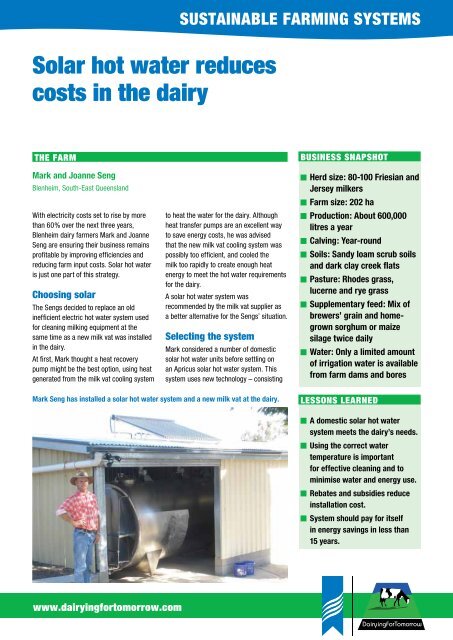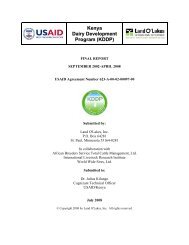solar hot water reduces costs in the dairy - Dairy Sustainability Website
solar hot water reduces costs in the dairy - Dairy Sustainability Website
solar hot water reduces costs in the dairy - Dairy Sustainability Website
Create successful ePaper yourself
Turn your PDF publications into a flip-book with our unique Google optimized e-Paper software.
Solar <strong>hot</strong> <strong>water</strong> <strong>reduces</strong><br />
<strong>costs</strong> <strong>in</strong> <strong>the</strong> <strong>dairy</strong><br />
Susta<strong>in</strong>able Farm<strong>in</strong>g Systems<br />
The Farm<br />
Mark and Joanne Seng<br />
Blenheim, South-East Queensland<br />
With electricity <strong>costs</strong> set to rise by more<br />
than 60% over <strong>the</strong> next three years,<br />
Blenheim <strong>dairy</strong> farmers Mark and Joanne<br />
Seng are ensur<strong>in</strong>g <strong>the</strong>ir bus<strong>in</strong>ess rema<strong>in</strong>s<br />
profitable by improv<strong>in</strong>g efficiencies and<br />
reduc<strong>in</strong>g farm <strong>in</strong>put <strong>costs</strong>. Solar <strong>hot</strong> <strong>water</strong><br />
is just one part of this strategy.<br />
Choos<strong>in</strong>g <strong>solar</strong><br />
The Sengs decided to replace an old<br />
<strong>in</strong>efficient electric <strong>hot</strong> <strong>water</strong> system used<br />
for clean<strong>in</strong>g milk<strong>in</strong>g equipment at <strong>the</strong><br />
same time as a new milk vat was <strong>in</strong>stalled<br />
<strong>in</strong> <strong>the</strong> <strong>dairy</strong>.<br />
At first, Mark thought a heat recovery<br />
pump might be <strong>the</strong> best option, us<strong>in</strong>g heat<br />
generated from <strong>the</strong> milk vat cool<strong>in</strong>g system<br />
to heat <strong>the</strong> <strong>water</strong> for <strong>the</strong> <strong>dairy</strong>. Although<br />
heat transfer pumps are an excellent way<br />
to save energy <strong>costs</strong>, he was advised<br />
that <strong>the</strong> new milk vat cool<strong>in</strong>g system was<br />
possibly too efficient, and cooled <strong>the</strong><br />
milk too rapidly to create enough heat<br />
energy to meet <strong>the</strong> <strong>hot</strong> <strong>water</strong> requirements<br />
for <strong>the</strong> <strong>dairy</strong>.<br />
A <strong>solar</strong> <strong>hot</strong> <strong>water</strong> system was<br />
recommended by <strong>the</strong> milk vat supplier as<br />
a better alternative for <strong>the</strong> Sengs’ situation.<br />
Select<strong>in</strong>g <strong>the</strong> system<br />
Mark considered a number of domestic<br />
<strong>solar</strong> <strong>hot</strong> <strong>water</strong> units before settl<strong>in</strong>g on<br />
an Apricus <strong>solar</strong> <strong>hot</strong> <strong>water</strong> system. This<br />
system uses new technology – consist<strong>in</strong>g<br />
Bus<strong>in</strong>ess snaps<strong>hot</strong><br />
• Herd size: 80-100 Friesian and<br />
Jersey milkers<br />
• Farm size: 202 ha<br />
• Production: About 600,000<br />
litres a year<br />
• Calv<strong>in</strong>g: Year-round<br />
• Soils: Sandy loam scrub soils<br />
and dark clay creek flats<br />
• Pasture: Rhodes grass,<br />
lucerne and rye grass<br />
• Supplementary feed: Mix of<br />
brewers’ gra<strong>in</strong> and homegrown<br />
sorghum or maize<br />
silage twice daily<br />
• Water: Only a limited amount<br />
of irrigation <strong>water</strong> is available<br />
from farm dams and bores<br />
Mark Seng has <strong>in</strong>stalled a <strong>solar</strong> <strong>hot</strong> <strong>water</strong> system and a new milk vat at <strong>the</strong> <strong>dairy</strong>.<br />
Lessons learned<br />
• A domestic <strong>solar</strong> <strong>hot</strong> <strong>water</strong><br />
system meets <strong>the</strong> <strong>dairy</strong>’s needs.<br />
• Us<strong>in</strong>g <strong>the</strong> correct <strong>water</strong><br />
temperature is important<br />
for effective clean<strong>in</strong>g and to<br />
m<strong>in</strong>imise <strong>water</strong> and energy use.<br />
• Rebates and subsidies reduce<br />
<strong>in</strong>stallation cost.<br />
• System should pay for itself<br />
<strong>in</strong> energy sav<strong>in</strong>gs <strong>in</strong> less than<br />
15 years.<br />
www.<strong>dairy</strong><strong>in</strong>gfortomorrow.com
of an array of 30 absorber tubes which<br />
concentrate and transfer heat to a<br />
collector manifold – to collect <strong>the</strong> sun’s<br />
energy. Water is pumped through <strong>the</strong><br />
manifold when <strong>the</strong> <strong>water</strong> temperature<br />
<strong>in</strong> <strong>the</strong> manifold is higher than that of <strong>the</strong><br />
storage tank. The round surface allows <strong>the</strong><br />
absorber tubes to passively track <strong>the</strong> sun,<br />
ensur<strong>in</strong>g greater <strong>solar</strong> performance. The<br />
manufacturers claim <strong>the</strong> system is highly<br />
efficient, even <strong>in</strong> extremely cold areas.<br />
If <strong>the</strong> <strong>water</strong> temperature gets too high, <strong>the</strong><br />
circulation pump shuts down so no fur<strong>the</strong>r<br />
heat<strong>in</strong>g or damage to <strong>the</strong> unit occurs.<br />
To ensure <strong>the</strong>re is adequate <strong>hot</strong> <strong>water</strong> on<br />
overcast days, <strong>the</strong> 315-litre storage tank is<br />
equipped with an electric booster element<br />
which is only activated at night on off-peak<br />
power, if required.<br />
The collector weighs only 120 kg and<br />
can be <strong>in</strong>stalled on most roofs without<br />
extra support. Due to <strong>the</strong> evacuated tube<br />
system’s design, clean<strong>in</strong>g or ma<strong>in</strong>tenance<br />
are rarely needed.<br />
The only modification required to<br />
this domestic system was to omit a<br />
temperature limit<strong>in</strong>g valve, a safety<br />
requirement for domestic <strong>hot</strong> <strong>water</strong><br />
systems. To reduce heat loss and fur<strong>the</strong>r<br />
improve efficiency, all copper pipes<br />
between <strong>the</strong> collector <strong>the</strong> storage tank and<br />
<strong>the</strong> outlet taps are well <strong>in</strong>sulated<br />
Water and energy use<br />
Mark m<strong>in</strong>imises <strong>water</strong> and energy used<br />
<strong>in</strong> <strong>the</strong> <strong>dairy</strong> by us<strong>in</strong>g only registered<br />
clean<strong>in</strong>g agents and recommended <strong>water</strong><br />
temperatures for each agent. Overheated<br />
<strong>water</strong> not only <strong>in</strong>creases energy <strong>costs</strong>,<br />
but can reduce <strong>the</strong> effectiveness of <strong>the</strong><br />
The round absorber tubes passively track <strong>the</strong> sun.<br />
Water and temperatures used for clean<strong>in</strong>g <strong>the</strong> milk<strong>in</strong>g mach<strong>in</strong>e and vat.<br />
Purpose Total <strong>water</strong> used Hot <strong>water</strong><br />
L/day<br />
clean<strong>in</strong>g agent and can result <strong>in</strong> high Total<br />
Plate Counts (TPC).<br />
The Sengs use a total of 119 litres of<br />
<strong>hot</strong> <strong>water</strong> <strong>in</strong> <strong>the</strong> <strong>dairy</strong> per day, <strong>in</strong>clud<strong>in</strong>g<br />
clean<strong>in</strong>g <strong>the</strong> milk<strong>in</strong>g mach<strong>in</strong>e and vat.<br />
Correct <strong>water</strong> temperatures are important<br />
for effective clean<strong>in</strong>g results.<br />
The new Westfalia Surge milk vat has an<br />
automated self-clean<strong>in</strong>g system with an<br />
<strong>in</strong>dependent <strong>hot</strong> <strong>water</strong> system which was<br />
fed by cold <strong>water</strong> directly from <strong>the</strong> ra<strong>in</strong><br />
<strong>water</strong> tanks. To fur<strong>the</strong>r reduce <strong>the</strong> energy<br />
bill, Mark has modified <strong>the</strong> plumb<strong>in</strong>g so<br />
that all <strong>hot</strong> <strong>water</strong> is heated by <strong>the</strong> <strong>solar</strong><br />
system first.<br />
Costs, rebates and subsidies<br />
The unit was bought from Solar<br />
Distributers, Toowoomba, <strong>in</strong> late March<br />
2010. The <strong>costs</strong> (exclud<strong>in</strong>g GST) were:<br />
Unit cost $4,300<br />
Roof frame $300<br />
Installation $1,993<br />
Total cost $6,593<br />
RECs (35@$36) - $1,250<br />
Balance $5,345<br />
The number of eligible RECs varies and<br />
depends on <strong>the</strong> brand and model of <strong>the</strong><br />
system, <strong>the</strong> <strong>in</strong>stallation date, <strong>the</strong> location,<br />
and <strong>the</strong> market value of RECs on <strong>the</strong> day.<br />
This will all be much simpler from January<br />
2011 when <strong>the</strong> Australian Government is<br />
fix<strong>in</strong>g <strong>the</strong> up-front subsidy at $40 per REC<br />
for all <strong>solar</strong> panels and <strong>solar</strong> <strong>hot</strong> <strong>water</strong><br />
systems. A typical domestic size <strong>hot</strong> <strong>water</strong><br />
system will be eligible for $1,200 (Refer to<br />
website www.orer.gov.au for more details).<br />
The Sengs were also eligible for a $2,800<br />
grant through <strong>the</strong>ir <strong>in</strong>volvement <strong>in</strong> <strong>the</strong><br />
Lockyer <strong>Dairy</strong><strong>in</strong>g Better ’n Better for<br />
Tomorrow group and a susta<strong>in</strong>ability<br />
project funded by Landcare Australia and<br />
Woolworths.<br />
Effectiveness and sav<strong>in</strong>gs<br />
The <strong>solar</strong> <strong>hot</strong> <strong>water</strong> system has proven<br />
to be highly efficient with <strong>the</strong> <strong>water</strong><br />
temperature reach<strong>in</strong>g 82°C without <strong>the</strong><br />
use of electricity when it was <strong>in</strong>stalled <strong>in</strong><br />
March 2010. Previously around 4,000 kW<br />
per year of electricity was used for <strong>hot</strong><br />
<strong>water</strong> <strong>in</strong> <strong>the</strong> <strong>dairy</strong>, cost<strong>in</strong>g $280 on a night<br />
rate of 6.99 ¢/kW hr.<br />
Mark expects at least 15 years of reliable<br />
service from <strong>the</strong> <strong>solar</strong> <strong>hot</strong> <strong>water</strong> system,<br />
and with electricity <strong>costs</strong> expected to rise<br />
by 60% over <strong>the</strong> next three years, <strong>the</strong><br />
Sengs should save at least $360 per year<br />
on power bills or $5,400 over <strong>the</strong> life of <strong>the</strong><br />
unit (based on 80% <strong>solar</strong> energy used).<br />
The <strong>solar</strong> <strong>hot</strong> <strong>water</strong> system should pay for<br />
itself, a good outcome consider<strong>in</strong>g <strong>the</strong> old<br />
system was due for replacement anyway.<br />
Useful websites<br />
The Office of <strong>the</strong> Renewable Energy<br />
Regulator: www.orer.gov.au<br />
<strong>Dairy</strong>SA Fact Sheets: www.<br />
<strong>dairy</strong><strong>in</strong>gfortomorrow.com/<strong>in</strong>dex.<br />
phpid=52 on heat<strong>in</strong>g <strong>water</strong>, cool<strong>in</strong>g milk,<br />
<strong>water</strong> <strong>in</strong> <strong>the</strong> <strong>dairy</strong> and renewable energy<br />
sources<br />
contact<br />
<strong>Dairy</strong><strong>in</strong>g for Tomorrow Coord<strong>in</strong>ator at <strong>the</strong><br />
Queensland <strong>Dairy</strong>farmers’ Organisation<br />
on (07) 3236 2955, mobile 0427 669 994<br />
or e-mail nrm@<strong>dairy</strong>page.com.au<br />
Temp<br />
C°<br />
Milk<strong>in</strong>g mach<strong>in</strong>es 60 L twice daily after milk<strong>in</strong>g us<strong>in</strong>g Dasco – Klenz <strong>in</strong> One 60 38-40<br />
Caustic <strong>hot</strong> wash 70 L once each week us<strong>in</strong>g DeLaval - PowerPack 10 70<br />
milk<strong>in</strong>g mach<strong>in</strong>es<br />
Milk vat wash 250 L/wash every second day 49 65<br />
Total <strong>dairy</strong> 165 L/day 119<br />
www.<strong>dairy</strong><strong>in</strong>gfortomorrow.com




